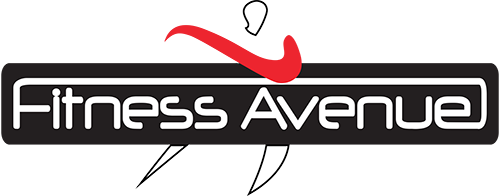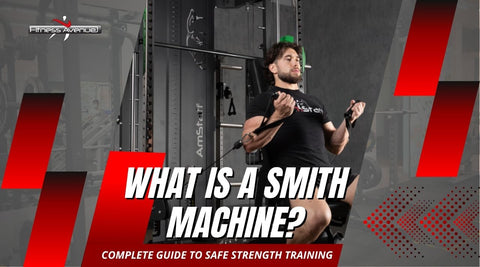When searching for what a Smith machine is, you're likely looking for a safer way to build strength at home or enhance your gym routine. Smith machines address the common pain point of training alone by combining guided resistance with built-in safety features.
With our expertise at Fitness Avenue, serving Canadian fitness enthusiasts since 2007, we'll guide you through everything you need to know about these versatile strength training machines that have transformed countless home gym setups across Canada and beyond.
What Exactly is A Smith Machine?

A Smith machine is a weight training apparatus featuring a barbell fixed within vertical steel rails, allowing only up-and-down movement along a predetermined fixed path. This guided resistance system eliminates the need for balance and stabilization, enabling focused muscle engagement while providing enhanced safety through adjustable catch mechanisms.
The core design includes a counterbalanced barbell (typically weighing 15-25 lbs rather than the standard 45 lbs), safety hooks positioned at various heights, and smooth bearings for fluid movement. Modern smith machines often integrate additional features, such as cable systems, pull-up bars, and functional trainer attachments, transforming them into comprehensive strength training centers.
Benefits of Using a Smith Machine
Smith machines offer several advantages that make them invaluable for both beginners and experienced lifters seeking safer, more controlled training sessions.
Enhanced Safety and Solo Training Capability
The fixed bar path eliminates the risk of weight plates shifting or the barbell falling during lifts. Safety stops automatically arrest the bar's descent if you reach muscle failure, allowing you to lift heavy weights without needing a spotter. This feature proves particularly valuable for exercises such as the Smith machine bench press, the Smith machine squat, and shoulder presses, where losing control could result in serious injury.
Superior Muscle Isolation and Targeted Development
By eliminating the need for stabilization, Smith machines enable a concentrated focus on primary muscle groups while providing added stability. Your primary leg muscles receive maximum engagement when performing squats without energy being diverted to balance maintenance. This isolation proves beneficial for rehabilitation, bodybuilding-focused training, and learning proper movement patterns.
Progressive Overload and Consistent Form
The guided movement ensures consistent bar path repetition after repetition, promoting better muscle memory and form development. The ability to safely handle heavy weights facilitates progressive overload—the foundation of strength training and muscle growth. Beginners can focus entirely on lifting technique without worrying about balance or coordination.
Smith Machine Exercises to Try With The Smith Machine
Smith machines accommodate a comprehensive range of exercises targeting every major muscle group, making them excellent centerpieces for a full-body workout routine.

Upper Body Development
The Smith machine bench press becomes a safer and more controlled exercise, allowing for focused development of the chest, shoulders, and triceps. Incline press and decline variations target different areas of the pectoral region. Shoulder presses work the deltoids and upper back without requiring spotter assistance. Bent-over rows effectively target the latissimus dorsi and rhomboids when performed with proper hip hinge mechanics.
Lower Body Strength
Smith machine squats offer excellent development of the quadriceps and glutes while accommodating various stance widths and foot positions. Forward foot placement enables deeper squats with reduced stress on the lower back. Bulgarian split squats, lunges, and step-ups become more controlled and safer to execute. Calf raises can be performed with substantial weight to promote the development of the gastrocnemius and soleus muscles.
Full-Body Integration
Upright rows target the upper traps and deltoids. Hip thrusts for glute development become more comfortable with the guided bar path. Shrugs effectively work the trapezius muscles. Many all-in-one models like our AmStaff SD-2500 include cable attachments for crossovers, lat pulldowns, and functional movement patterns.
How to Choose a Smith Machine?
Selecting the ideal Smith machine requires careful consideration of space, capacity, features, and fitness goals to ensure long-term satisfaction and safety.
Weight Capacity and Construction Quality
Determine your strength goals and select a machine with a capacity that matches your needs. Home models typically support 300-500 lbs, while commercial-grade units handle 600- 1000+ lbs. Our AmStaff SD360 Functional Smith Machine 2.0 offers excellent capacity for most home users, featuring solid steel construction and smooth bearings.
Space Requirements and Footprint
Measure your available area carefully, taking into account the clearance around the machine. Compact models fit in smaller spaces, while full-featured units, such as our AmStaff SD-2500, provide maximum exercise variety but require more room. Consider ceiling height for vertical movements and plate storage needs.
Additional Features and Versatility
Multi-functional models offer superior value by combining Smith machine functionality with cable systems, parallel bars, and dip stations, providing a comprehensive range of exercises. These all-in-one designs maximize exercise variety while minimizing the need for gym equipment. Look for smooth bearing systems, adjustable safety catches, and quality construction materials for durability.
Do Smith Machines Make Weight-Training Exercises Easier?
Smith machines create a different training stimulus rather than simply making strength training exercises "easier." The guided bar path eliminates balance requirements, allowing focus on targeted muscle groups while often enabling heavier weight handling due to increased stability.
However, this stability comes at a cost. Stabilizer muscles receive less activation compared to free weights, potentially creating strength imbalances if Smith machines comprise your entire training program. The fixed path may not perfectly align with your natural range of motion, requiring adjustments to your stance and grip to achieve optimal performance.
The counterbalanced bar system does reduce the starting weight, making initial movements more accessible for beginners. This feature helps newcomers develop proper form and build confidence before progressing to heavier loads or transitioning to free weights.
What Exercises Should You Avoid Doing On The Smith Machine?
While Smith machines accommodate most exercises safely, certain movements work better with free weights or alternative equipment to maximize effectiveness and maintain proper form.
Deadlifts present challenges due to the vertical bar path conflicting with the natural forward lean required for proper deadlift mechanics. Free weight exercises better develop posterior chain strength and proper hip hinge patterns. If using a Smith machine for deadlifts, focus on Romanian or stiff-leg variations rather than conventional pulls from the floor.
Olympic lifts, such as cleans and snatches, require explosive, multi-directional movement that the Smith machine's fixed path restricts. These exercises demand dynamic balance and coordination that guided systems cannot replicate. Stick to barbells and bumper plates for Olympic lifting.
Single-arm or unilateral exercises lose much of their functional benefit when performed on Smith machines, as the stability challenges that make these movements valuable are eliminated. Free weights or cable systems are better suited for unilateral training goals.
Why is A Smith Machine Power Rack Attachment Worthwhile?
Smith machine attachments for existing power racks offer an excellent compromise between safety and versatility while maximizing space efficiency in home gym setups. These systems add guided resistance capability to your current setup without requiring a complete overhaul of your equipment.
Space and Cost Efficiency
Attachments integrate into existing rack systems, avoiding the need for separate floor space. This approach proves more economical than purchasing dedicated Smith machines while providing similar safety benefits. Quality attachments maintain the structural integrity of your power rack while adding new training possibilities.
Versatility and Functionality
Many attachment systems offer adjustable angles, allowing for slight deviations from pure vertical movement to match natural biomechanics better. This flexibility offers the benefits of both guided and free-weight training within a single system, providing a comprehensive approach to training. Users find they can quickly switch between traditional rack exercises and Smith machine movements during workouts.
Upgrade Path and Modularity
Attachments allow gradual gym expansion as needs evolve. Start with basic rack functionality, add Smith capabilities later, then incorporate cable systems or other accessories over time. This modular approach spreads costs while building comprehensive training environments suited to changing fitness goals.
Also read: How to Choose a Power Rack
FAQs
Is the Smith machine good for beginners?
Yes, Smith machines excel for beginners by providing safety, stability, and confidence during the learning process. The guided bar path eliminates balance concerns, allowing newcomers to focus exclusively on proper form and muscle engagement. Safety catches prevent accidents during muscle failure, enabling solo training without spotter assistance. The counterbalanced bar system reduces starting weight, making initial strength training more accessible. However, beginners should eventually incorporate free weights to engage stabilizer muscles and the natural range of motion for comprehensive muscle development.
What are the disadvantages of the Smith Machine?
Smith machines limit the development of stabilizer muscles due to the fixed bar path, potentially creating strength imbalances if used exclusively. The vertical movement pattern may not match natural biomechanics for all individuals, requiring stance adjustments that feel awkward initially. The guided system can create dependency, making the transition to free weights challenging for some users. Additionally, the fixed path restricts exercise variety compared to free weights, and some movements, such as deadlifts, become less effective due to biomechanical constraints.
What is the difference between a squat rack and a Smith Machine?
Squat racks provide adjustable bar supports for free weight training, requiring full stabilization and balance during exercises. Users must control the barbell in three dimensions, engaging stabilizer muscles and developing functional strength. Smith machines feature guided vertical movement with built-in safety mechanisms, eliminating balance requirements while providing consistent bar paths. Squat racks offer an unlimited variety of exercises and a more natural range of motion, while Smith machines provide enhanced safety and targeted muscle isolation. Many home gym owners benefit from having both Smith machines for comprehensive training options.
Is the Smith machine as good as free weights?
Smith machines and free weights serve different training purposes, with neither being universally superior. Free weights develop functional fitness, balance, and stabilizer muscles through unrestricted movement patterns. Smith machines excel at muscle isolation, offer increased safety, and facilitate progressive overload without the need for a spotter. The ideal approach combines both methods—using free weights for foundational strength and coordination while leveraging Smith machines for targeted muscle development and solo heavy lifting. This balanced strategy maximizes training benefits while addressing the limitations of each system for all fitness levels.
Key Takeaways
Smith machines represent one valuable addition to any strength training program, offering enhanced safety and targeted muscle development through guided resistance systems. The fixed bar path eliminates balance requirements, enabling focused muscle engagement, while built-in safety features allow for confident heavy lifting without the need for spotters.
These versatile machines accommodate comprehensive exercise routines that target multiple muscle groups, including squats, bench presses, rows, and other exercises. Modern all-in-one models like our AmStaff collection combine smith functionality with cable systems and additional training stations for maximum versatility.
When selecting a standard Smith machine, prioritize weight capacity, construction quality, space requirements, and feature sets that align with your training goals. While a Smith machine offers distinct advantages, combining it with free weight training creates the most comprehensive strength development program.
At Fitness Avenue, we've helped Canadian fitness enthusiasts build muscle and create effective home gym setups since 2007. Our expert team guides equipment selection, and we offer fast shipping across Canada and the US to get your training started quickly. Visit our showrooms in Toronto, Barrie, Longueuil, and London to experience our smith machines firsthand, or explore our complete selection online to find the perfect addition to your fitness journey.
Citations:
[1] https://www.ncbi.nlm.nih.gov/pmc/articles/PMC7745739/
[2] https://journals.lww.com/nsca-jscr/fulltext/2009/12000/a_biomechanical_comparison_of_the_traditional.31.aspx



